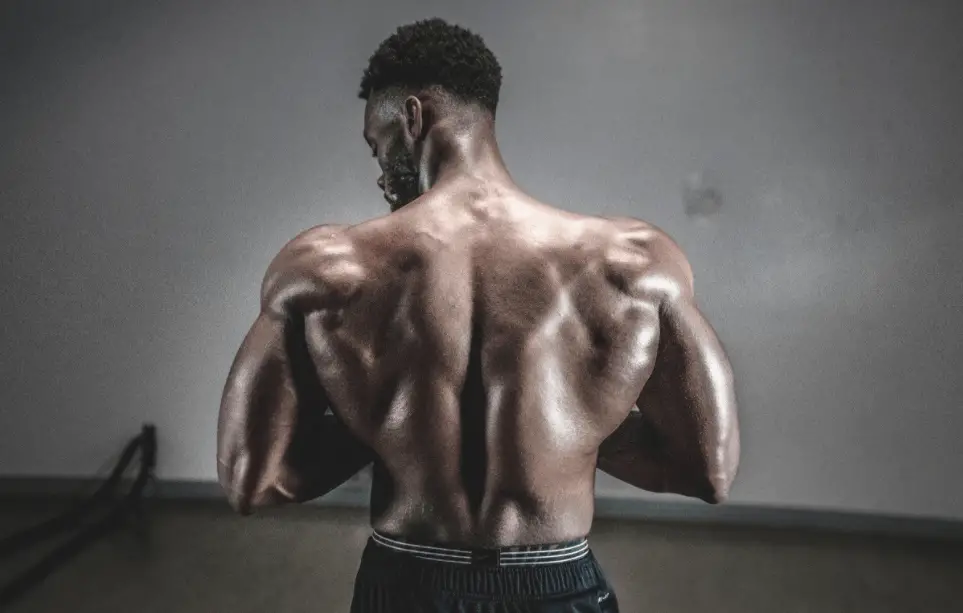Doing pull-ups every day because we’ve seen it in a Rocky 6 montage might look great but is it good to do? Some variation of a pull-up should be in your workout routine, but to do it every day goes against a lot of the science. The old saying “less is more” is highly relevant in answering this question. In short, you probably shouldn’t be doing pull-ups every day if your goal is strength, muscle growth, endurance, or to do more pull-ups!
Table of Contents
Benefits Of Pull-Ups
A pull-up is one of the best bodyweight movements that build strength, endurance, and muscle mass in your upper body. It’s a highly convenient compound exercise that targets multiple muscles together.
By doing pull-ups everyday you’ll benefit from:
- Increase muscular endurance
- Build bigger and stronger back muscles (see image below)
- Improve grip strength over time
- Build stronger biceps and forearms
- Generate more functional strength
- Sculpt a V-shape body
- Development of hand strength
You’ll notice that any gym or training facility is bound to have at least one pull up bar, and you’ll be sure to find athletes doing pull-ups on this every day. If you’re training pull-ups for strength and use additional weight belts you’ll definitely want to allow at least one day of rest between the exercise for recovery.
The pull-up primary targets the Latissimus Dorsi or “Lats”, the Trapezius or “traps”, and Rear Deltoids. The secondary muscles used are the Biceps. Additionally, a pull-up with good form will engage your core abdominal region and trunk.

It’s not just the strength and aesthetics that you should focus on. Pull-ups are also a functional movement that carries through in your daily activities. Anytime you’re pulling, holding, or reaching something heavy you’re engaging the same muscles used during a pull-up. Additionally, this compound exercise utilizes multiple joints too.
The average man can do roughly 2-3 full-range repetitions of a pull-up. This is considerably low compared to anyone (man or woman) who has spent some time training their back muscles and the pull-up movement. It is fairly straight forward to improve the humbling number of 3 pull-ups to 10 in a matter of months with proper training. Using an assisted pull-up machine can do wonders.
On the other hand, a Navy Seal Officer must be able to do 20 pull-ups. Next time you’re doing pull-ups see how close you get to that!
Can You Do Pull-Ups Every Day?
Is it bad to do pull-ups every day? The short answer is yes. You will reap more benefits by allowing time for your muscles to rest and recover between workouts so you’re performing at an optimal level. Doing pull-ups every day will not benefit you as much as calculated rest in between training as recommended by the National Strength and Conditioning Association (NSCA). At least one day of rest between resistance training sessions before working the same muscles again has a greater overall benefit than doing pull-ups every day. This is an intermediate to an advanced level movement that utilizes multiple muscles and joints and therefore overloading the muscles and joints each day can potentially lead to injury.
Moreover, the damage caused by inflammation peaks somewhere between 24 to 48 hours. Training the same muscles through resistance workouts can cause incremental damage during this period. After watching a David Goggins video and feeling absolutely pumped to “conquer your inner bitch”
If you’re an intermediate to an advanced level athlete then pull-ups every other day could be an option for you. It’s paramount to understand and listen to your body and adapt accordingly. This is so that you know when you’re getting enough rest and if you’re increasing your strength and endurance.
Pull-Up Variations
The body and muscles are incredibly quick to adapt to routines. If we’re always performing the same exercises with no variation we can easily hit a wall with progress. There are plenty of ways to improve pull-ups by changing the exercise. There isn’t a clear answer as to whether chin-ups or pull-ups are better, the answer depends on your goals.
- Wide Grip: An overhand wide grip is more advanced and heavily targets the lats, delts, and traps, taking some load off the biceps
- Medium Grip: Is an optimal grip to build strength and endurance in your back and forearms as well as grip strength
- Chin Up: Is heavily focused on your biceps, traps.
- Single Handed: For advanced users, a single-handed pull up will seriously improve your grip strength, balance, and core stability.

Exercises To Improve Pull-Ups
If you’re unable to perform a single pull up there are 2 key exercises to help build the strength and muscle mass to eventually get to a pull-up. Additionally, if you want to get better at pull-ups you can use these moves too.
The lat pull down cable machine is highly recommended as it mirrors the same movement but with a stack of weights while you’re seated. Although, it doesn’t factor in balance and core strength which you’d be working on with an actual pull-up. The pull down machine will help to grow your back and forearm muscles as well as quickly improving your grip. You can switch this up to single arm for greater lat focus.
The assisted pull-up takes the form of a machine that has a counterweight to make you lighter to perform a pull-up. This is a great exercise that will allow you to gradually build strength and in time perform a pull-up without assistance. You can achieve 15 pull-ups in 15 weeks as a challenge by starting with the heaviest weight, and each week dropping ~5-10% of your body weight from the stack.
Conclusion
Having a strong back is important for a plethora of reasons. In order to get to the end result you want, ensuring you train safely, properly, and get enough sleep and recovery as an athlete will bring you closer to your goals.
Growing the muscles in your back provides strength and stability for your spine and posture which is required for all people in everyday life. If you’re an athlete, and especially in combat sports like wrestling or MMA then a strong back and shoulder are integral. We’ve noted this in our popular 12-week training program for wrestlers. As well as a strong back, having the power and speed in your hips, especially in Mixed Martial Arts is crucial for success and longevity.

